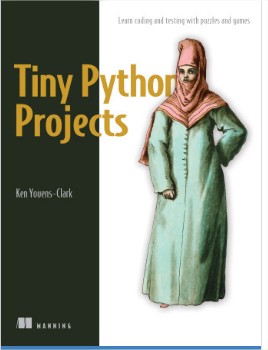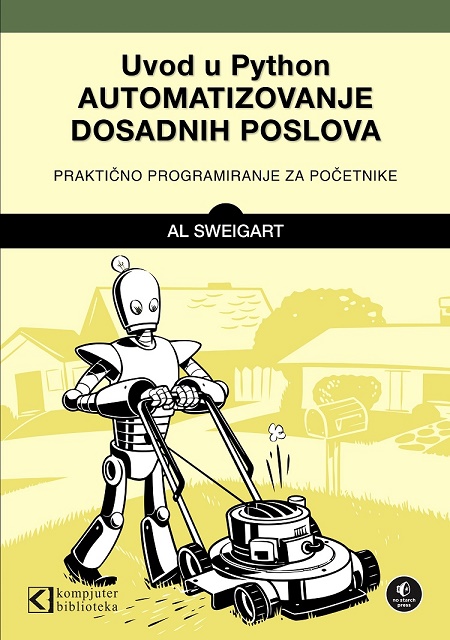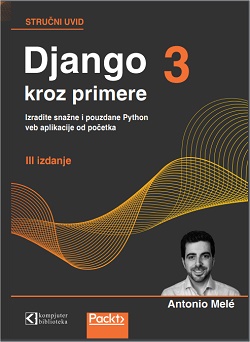
Autor:
Broj strana: 440
ISBN broj: 9781617297519
Izdavač:
MANNING PUBLICATIONS ![]()
Godina izdanja: 2020.
 |
 |
 |
 |
 |
||||
Tiny Python Projects is a gentle, amusing introduction to Python that will firm up several key concepts while occasionally making you snicker. Amanda Debler, Schaeffler Technologies A long journey is really a lot of little steps. The same is true when you’re learning Python, so you may as well have some fun along the way! Written in a lighthearted style with entertaining exercises that build powerful skills, Tiny Python Projects takes you from amateur to Pythonista as you create 22 bitesize programs. Each tiny project teaches you a new programming concept, from the basics of lists and strings right through to regular expressions and randomness. Along the way you’ll also discover how testing can make you a better programmer in any language.
Who says learning to program has to be boring? The 21 activities in this book teach Python fundamentals through puzzles and games. Not only will you be entertained with every exercise, but you’ll learn about text manipulation, basic algorithms, and lists and dictionaries as you go. It’s the ideal way for any Python newbie to gain confidence and experience.
The projects are tiny, but the rewards are big: each chapter in Tiny Python Projects challenges you with a new Python program, including a password creator, a word rhymer, and a Shakespearean insult generator. As you complete these entertaining exercises, you’ll graduate from a Python beginner to a confident programmer—and you’ll have a good time doing it!
Who Am I?
Who Are You?
Why Did I Write This Book?
0.1 Using test-driven development
0.2 Setting up your environment
0.3 Code examples
0.4 Getting the code
0.5 Installing modules
0.6 Code formatters
0.7 Code linters
0.8 How to start writing new programs
0.9 Why Not Notebooks?
0.10 The scope of topics we cover
0.11 Why not object-oriented programming?
0.12 A Note about the lingo
1.1 Comment lines
1.2 Testing our program
1.3 Adding the shebang line
1.4 Making a program executable
1.5 Understanding $PATH
1.6 Altering your $PATH
1.7 Adding a parameter and help
1.8 Making the argument optional
1.9 Running our tests
1.10 Adding the main() function
1.11 Adding the get_args() function
1.11.1 Checking style and errors
1.12 Testing hello.py
1.13 Starting a new program with new.py
1.14 Using template.py as an alternative to new.py
1.15 Summary
2.1 Getting started
2.1.1 How to use the tests
2.1.2 Creating programs with new.py
2.1.3 Write, test, repeat
2.1.4 Defining your arguments
2.1.5 Concatenating strings
2.1.6 Variable types
2.1.7 Getting just part of a string
2.1.8 Finding help in the REPL
2.1.9 String methods
2.1.10 String comparisons
2.1.11 Conditional branching
2.1.12 String formatting
2.2 Solution
2.3 Discussion
2.3.1 Defining the arguments with get_args
2.3.2 The main thing
2.3.3 Classifying the first character of a word
2.3.4 Printing the results
2.3.5 Running the test suite
2.4 Summary
2.5 Going Further
3.1 Starting the program
3.2 Writing picnic.py
3.3 Introduction to lists
3.3.1 Adding one element to a list
3.3.2 Adding many elements to a list
3.3.3 Indexing lists
3.3.4 Slicing lists
3.3.5 Finding elements in a list
3.3.6 Removing elements from a list
3.3.7 Sorting and reversing a list
3.3.8 Lists are mutable
3.3.9 Joining a list
3.4 Conditional branching with if/elif/else
3.5 Solution
3.6 Discussion
3.6.1 Defining the arguments
3.6.2 Assigning and sorting the items
3.6.3 Formatting the items
3.6.4 Printing the items
3.7 Summary
3.8 Going Further
4.1 Dictionaries
4.1.1 Creating a dictionary
4.1.2 Accessing dictionary values
4.1.3 Other dictionary methods
4.2 Writing jump.py
4.3 Solution
4.4 Discussion
4.4.1 Defining the arguments
4.4.2 Using a dict for encoding
4.4.3 Method 1: Using a for loop to print() each character
4.4.4 Method 2: Using a for loop to build a new string
4.4.5 Method 3: Using a for loop to build a new list
4.4.6 Method 4: Turning a for loop into a list comprehension
4.4.7 Method 5: Using the str.translate() function
4.4.8 (Not) using str.replace()
4.5 Summary
4.6 Going Further
5.1 Reading files
5.2 Writing files
5.3 Writing howler.py
5.4 Solution
5.5 Discussion
5.5.1 Defining the arguments
5.5.2 Reading input from a file or the command line
5.5.3 Choosing the output file handle
5.5.4 Printing the output
5.5.5 A low-memory version
5.6 Review
5.7 Going Further
6.1 Writing wc.py
6.1.1 Defining file inputs
6.1.2 Iterating lists
6.1.3 What you’re counting
6.1.4 Formatting your results
6.2 Solution
6.3 Discussion
6.3.1 Defining the arguments
6.3.2 Reading a file using a for loop
6.4 Review
6.5 Going Further
7.1 Writing gashlycrumb.py
7.2 Solution
7.3 Discussion
7.3.1 Handling the arguments
7.3.2 Reading the input file
7.3.3 Using a dictionary comprehension
7.3.4 Dictionary lookups
7.4 Review
7.5 Going Further
8.1 Altering strings
8.1.1 Using the str.replace() method
8.1.2 Using str.translate()
8.1.3 Other ways to mutate strings
8.2 Solution
8.3 Discussion
8.3.1 Defining the parameters
8.4 Eight ways to replace the vowels
8.4.1 Method 1: Iterate every character
8.4.2 Method 2: Using the str.replace() method
8.4.3 Method 3: Using the str.translate() method
8.4.4 Method 4: List comprehension
8.4.5 Method 5: List comprehension with function
8.4.6 Method 6: The map() function
8.4.7 Method 7: Using map() with a defined function
8.4.8 Method 8: Using regular expressions
8.5 Refactoring with tests
8.6 Review
8.7 Going Further
9.1 Writing abuse.py
9.1.1 Validating arguments
9.1.2 Importing and seeding the random module
9.1.3 Defining the adjectives and nouns
9.1.4 Taking random samples and choices
9.1.5 Formatting the output
9.2 Solution
9.3 Discussion
9.3.1 Defining the arguments
9.3.2 Using parser.error()
9.3.3 Program exit values and STDERR
9.3.4 Controlling randomness with random.seed()
9.3.5 Iterating for loops with range()
9.3.6 Constructing the insults
9.4 Review
9.5 Going Further
10.1 More briefing
10.2 Writing telephone.py
10.3 Calculating the number of mutations
10.4 The mutation space
10.5 Selecting the characters to mutate
10.5.1 Non-deterministic selection
10.5.2 Randomly sampling characters
10.6 Mutating a string
10.7 Time to write
10.8 Solution
10.9 Discussion
10.9.1 Defining the arguments
10.9.2 Mutating a string
10.9.3 Using a list instead of a str
10.10 Review
10.11 Going Further
11.1 Writing bottles.py
11.2 Counting down
11.3 Writing a function
11.4 Writing a test for verse()
11.5 Using the verse() function
11.6 Solution
11.7 Discussion
11.7.1 Defining the arguments
11.7.2 Counting down
11.7.3 Test-Driven Development
11.7.4 The verse() function
11.7.5 Iterating through the verses
11.7.6 1500 other solutions
11.8 Review
11.9 Going Further
12.1 Writing ransom.py
12.1.1 Mutating the text
12.1.2 Flipping a coin
12.1.3 Creating a new string
12.2 Solution
12.3 Discussion
12.3.1 Iterating through elements in a sequence
12.3.2 Writing a function to choose the letter
12.3.3 Another way to write list.append()
12.3.4 Using a str instead of a list
12.3.5 Using a list comprehension
12.3.6 Using a map() function
12.4 Comparing methods
12.5 Review
12.6 Going Further
13.1 Writing twelve_days.py
13.1.1 Counting
13.1.2 Creating the ordinal value
13.1.3 Making the verses
13.1.4 Using the verse() function
13.1.5 Printing
13.1.6 Time to write
13.2 Solution
13.3 Discussion
13.3.1 Defining the arguments
13.3.2 Making one verse
13.3.3 Generating the verses
13.3.4 Printing the verses
13.4 Review
13.5 Going Further
14.1 Writing rhymer.py
14.1.1 Breaking a word
14.1.2 Using regular expressions
14.1.3 Using capture groups
14.1.4 Truthiness
14.1.5 Creating the output
14.2 Solution
14.3 Discussion
14.3.1 Stemming a word
14.3.2 Writing a regular expression
14.3.3 Testing and using the stemmer() function
14.3.4 Creating rhyming strings
14.3.5 Writing stemmer() without regular expressions
14.4 Review
14.5 Going Further
15.1 Writing friar.py
15.1.1 Splitting text using regular expressions
15.1.2 Shorthand classes
15.1.3 Negated shorthand classes
15.1.4 Using re.split() with a captured regex
15.1.5 Writing the fry() function
15.1.6 Using the fry() function
15.2 Solution
15.3 Discussion
15.3.1 Breaking text into lines
15.3.2 Writing the fry() function manually
15.3.3 Writing the fry() function with regular expressions
15.4 Review
15.5 Going Further
16.1 Writing scrambler.py
16.1.1 Breaking the text into lines and words
16.1.2 Capturing, non-capturing, and optional groups
16.1.3 Compiling a regex
16.1.4 Scrambling a word
16.1.5 Scrambling all the words
16.2 Solution
16.3 Discussion
16.3.1 Processing the text
16.3.2 Scrambling a word
16.4 Review
16.5 Going Further
17.1 Writing mad.py
17.1.1 Using regular expressions to find the pointy bits
17.1.2 Halting and printing errors
17.1.3 Getting the values
17.1.4 Substituting the text
17.2 Solution
17.3 Discussion
17.3.1 Defining the arguments
17.3.2 Substituting with regular expressions
17.3.3 Finding the placeholders without regular expressions
17.4 Review
17.5 Going Further
18.1 Writing gematria.py
18.1.1 Cleaning a word
18.1.2 Ordinal character values and ranges
18.1.3 Summing and reducing
18.1.4 Encoding the words
18.1.5 Breaking the text
18.2 Solution
18.3 Discussion
18.3.1 Writing word2num()
18.3.2 Sorting
18.3.3 Testing
18.4 Review
18.5 Going Further
19.1 Writing wod.py
19.1.1 Reading delimited text files
19.1.2 Manually reading a CSV file
19.1.3 Parsing with the csv module
19.1.4 Creating a function to read a CSV file
19.1.5 Selecting the exercises
19.1.6 Formatting the output
19.1.7 Handling bad data
19.1.8 Time to write!
19.2 Solution
19.3 Discussion
19.3.1 Reading a CSV file
19.3.2 Potentials run-time errors
19.3.3 Using pandas.read_csv() to parse the file
19.3.4 Formatting the table
19.4 Review
19.5 Going Further
20.1 Writing password.py
20.1.1 Creating a unique list of words
20.1.2 Cleaning the text
20.1.3 Using a set
20.1.4 Filtering the words
20.1.5 Titlecasing the words
20.1.6 Sampling and making a password
20.2 l33t-ify
20.2.1 Putting it all together
20.3 Solution
20.4 Discussion
20.4.1 Cleaning the text
20.4.2 A king’s ransom
20.4.3 How to l33t()
20.4.4 Processing the files
20.4.5 Sampling and creating the passwords
20.5 Review
20.6 Going Further
21.1 Writing tictactoe.py
21.1.1 Validating user input
21.1.2 Altering the board
21.1.3 Printing the board
21.1.4 Determining a winner
21.2 Solution
21.2.1 Validating the arguments and mutating the board
21.2.2 Formatting the board
21.2.3 Finding the winner
21.3 Review
21.4 Going further
22.1 Writing itictactoe.py
22.1.1 Tuple talk
22.1.2 Named Tuples
22.1.3 Adding type hints
22.1.4 Type verification with mypy
22.1.5 Updating immutable structures
22.1.6 Adding type hints to function definitions
22.2 Interactive solution
22.3 A version using TypedDict
22.3.1 Thinking about state
22.4 Review
22.5 Going further
Appendixes
A.1 Types of arguments
A.2 Starting off with new.py
A.3 Using argparse
A.3.1 Creating the parser
A.3.2 A positional parameter
A.3.3 An optional string parameter
A.3.4 An optional numeric parameter
A.3.5 An optional file parameter
A.3.6 A flag
A.3.7 Returning from get_args
A.4 Examples using argparse
A.4.1 A single, positional argument
A.4.2 Two different positional arguments
A.4.3 Restricting values using choices
A.4.4 Two of the same positional arguments
A.4.5 One or more of the same positional arguments
A.4.6 File arguments
A.4.7 Manually checking arguments
A.4.8 Automatic help
A.5 Summary
Write command-line Python programs Manipulate Python data structures Use and control randomness Write and run tests for programs and functions Download testing suites for each project
For readers with beginner programming skills.
Ken Youens-Clark is a Senior Scientific Programmer at the University of Arizona. He has an MS in Biosystems Engineering and has been programming for over 20 years.
Budite prvi koji će ostaviti komentar.

Popust cena:
1930.00 rsd

Popust cena:
2280.00 rsd
© Sva prava pridržana, Kompjuter biblioteka, Beograd, Obalskih radnika 4a, Telefon: +381 11 252 0 272 |
||